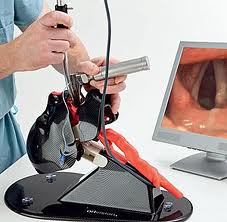“Tracheal intubation over a flexible endoscope is an invaluable technique in airway management, particularly in patients for whom standard larygoscopy and orotracheal intubation have failed, or are anticipated to be difficult or impossible.. Endoscopic devices are used both for diagnostic evaluation of the upper airway and for tracheal intubation.” (1)
The authors recommend that the endoscope bundle should be 600 mm which is long enough to allow ED bronchoscopy and pulmonary toilet if needed. A 400 mm intubating endoscope is not long enough for pulmonary care. There also needs to be a seperate channel for local anaesthetic injection or for saline injection and suctioning. Do not do insufflate oxygen through the suction channel (as was formerly recommended) as this has been followed by “several cases of gastric insufflation, perforation, and death.” (2)
 Endoscopic intubation needs to be learned from experts and practiced on mannikins. The authors state that reasonable skill in manipulating the bronchoscope can be acquired with 3 to 4 hours of independent practice using mannikins. And the skill can be learned in real-life cases when diagnostic evaluation is indicated such as seeking the cause of hoarseness or severe sore throat or in other upper airway conditions. “Because success [of endoscopic intubation] depends on familiarity and skill in using the device, gaining experience in routine cases is invaluable before one is required to perform a difficult endoscopic intubation in a crisis.” (3)
Endoscopic intubation needs to be learned from experts and practiced on mannikins. The authors state that reasonable skill in manipulating the bronchoscope can be acquired with 3 to 4 hours of independent practice using mannikins. And the skill can be learned in real-life cases when diagnostic evaluation is indicated such as seeking the cause of hoarseness or severe sore throat or in other upper airway conditions. “Because success [of endoscopic intubation] depends on familiarity and skill in using the device, gaining experience in routine cases is invaluable before one is required to perform a difficult endoscopic intubation in a crisis.” (3)
The technique of endoscopic intubation is well described in the Airway Management book. (4)
“Finally. . . [there is] the uncommon, but real risk of sudden and total airway obstruction in patients undergoing topical anesthesia for awake endoscopic intubation.” (5)
“In the presence of pre-existing airway compromise, topical anesthesia and instrumentation are associated with airway compromise resulting from dynamic airflow obstruction with or without associated laryngospasm. Preperation for immediate surgical airway control is a necessity whenever one applies topical anesthesia or performs instrumentation of an inflamed, compromised airway.” (6)
(1) Manual of Emergency Airway Management 4th ed, 2012. RM Walls and MF Murphy, p. 166.
(2) Ibid., p. 172.
(3) Ibid., p. 167.
(4) Ibid., pp. 170-172.
(5) Ibid., p. 172.
(6) Ibid., p. 274.




